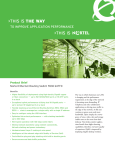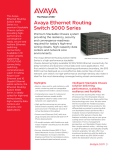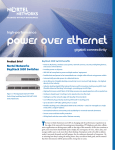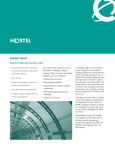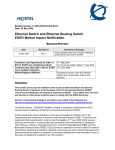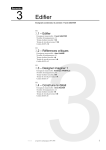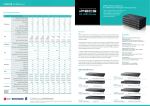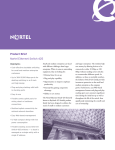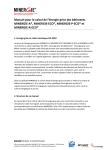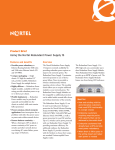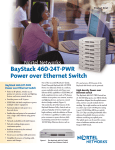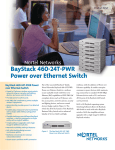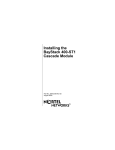Download Nortel Ethernet Switch 470-24T-PWR
Transcript
Product Brief Ethernet Switch 470 family Converged edge > Desktop connectivity > Power over Ethernet > IP Telephony > Wireless LAN Key features > High-speed desktop switching > Power over Ethernet > Resilient Stacking > Distributed Multi-Link Trunking > Quality of Service > Security features > Advanced management The Nortel Ethernet Switch 470 product family is a stackable solution that provides resiliency, security and convergence readiness required by today’s application- and competition-driven enterprise networks. The Ethernet Switch 470 family delivers Layer 2 switching with Power over Ethernet models for simplified network deployments to help drive lower Total Cost of Ownership. The Ethernet Switch 470 is available in four models: the Ethernet Switch 470-24T with 24 10/100 ports plus two Gigabit Interface Converters (GBICs) ports; the Ethernet Switch 470-48T Ethernet Switch 470-24T-PWR Ethernet Switch 470 stack Ethernet Switch 470-48T-PWR with 48 10/100 ports and two GBICs; the Ethernet Switch 470-24T-PWR with 24 10/100 ports supporting Power over Ethernet plus two GBICs; and the Ethernet Switch 470-48T with 48 10/100 ports supporting Power over Ethernet and two GBICs. All models include built-in stacking ports, redundant power support and are available in compact one Rack Unit (RU) high design. High-density desktop switching Up to eight Ethernet Switch 470-24T, 470-48T, 470-24T-PWR or 470-48TPWR may be combined in a single stack to support up to 384 10/100 ports and managed as a single entity. The Ethernet Switch 470-48T and 470-48T-PWR offer additional flexibility for uplink connection as ports 47 and 48 can be configured as either 10/100Base-T or GBIC. The Ethernet Switch 470-24T and 470-24TPWR may utilize all 26 ports simultaneously. The 2.56-Gbps cascading bandwidth on these switches offers dedicated bandwidth between the switches without sacrificing any uplink ports. The Ethernet Switch 460-24T-PWR can also be stacked with Ethernet Switch 470 or 470-PWR. The uplink ports can be used for connections to backbone switches such as the Ethernet Routing Switch 8600, 8300, 1600 or 5500. Power over Ethernet (470-PWR) IEEE 802.3af compliant The Ethernet Switch 470-PWR provides IEEE 802.3af standards-compliant Power over Ethernet (PoE) and is designed to power devices such as IP phones, wireless access points, network cameras, security and lighting devices, and access control devices (badge readers). The benefit of being interoperable with standards-based equipment means that customers are not forced to tie themselves to any one vendor, as the switch has the flexibility to power multiple vendors’ devices. The switch can supply power up to 15.4 Watts per port, which meets the IEEE 802.3af standard. Dynamic power management Each port on the Ethernet Switch 470PWR can be configured to limit the power delivered to a device. Each port can also be configured for power priority level — low, high and critical. On the switch, total available power is monitored. In the case where all available power is fully utilized, the switch may turn off lower priority ports and turn on higher priority ports. The Ethernet Switch 470-PWR can automatically disable a port if there is a short. All other ports on the switch will remain active and will not be affected by the disabled port. Figure 1. Built-in stacking ports Plug-n-play IP Telephony switching Automatic Discovery and Automatic Configuration (ADAC) capability enables the switch to detect Nortel IP Phones and automatically configure the port and QoS parameters. The Ethernet Switch 470-PWR provides simplified Java Device Manager and Web-based configurations on data and power properties. These graphical user interfaces make it simple to set up data and power configurations. Load sharing and redundant power for 470-PWR Ethernet Switch 470-24T-PWR or 47048T-PWR provides up to 370 watts of DTE power for Power over Ethernet devices. With the addition of a Redundant Power Supply RPS15 chassis and the 600-watt RPS15 power module, the Ethernet Switch 470-48T-PWR can support up to 740 watts of power. This solution will provide 15.4 W per port from the Ethernet Switch 470-48T-PWR. Additionally, the addition of an RPS15 chassis and power supply can be used to provide dual power feeds to the switch, ensuring higher availability where customers require their switches connected to more than one power feed. A DC connector cable is required to connect Table 1. Key differences between Nortel Ethernet Switch 470, 470-PWR and 460-PWR Feature 10/100 ports 470-PWR 460-PWR 24 / 48 24 / 48 24 No Yes Yes Built-in stacking Yes Yes No 2 2 2 (optional with MDA) No No 2 or 4 (optional with MDA) 1 RU 1 RU 1.5 RU 100Base-FX uplinks Height (RU = Rack Unit) 2 470 Power over Ethernet GBIC uplinks from an Ethernet Switch 470 or 470PWR to the RPS15 RPSU module (see Table 2 – Ordering information). Resilient Stacking Two Built-in Stacking Ports Ethernet Switch 470 models have two built-in stacking ports for simpler, quicker and more cost-effective stacking. This unique stacking design frees up both of the uplink ports for dedicated connectivity to the backbone. A 46cm/18” stacking cable is included with the product (Figure 1). A key differentiation for the Ethernet Switch 470 family is its resilient stacking feature. This switch can stack up to eight units with a resilient cascade stacking design, assuring continuous uptime even if a switch in the stack should fail (Figure 2). Auto Unit Replacement The Auto Unit Replacement (AUR) feature provides the user with the ability to retain the configuration (CFG) image of a unit in a stack during a unit replacement. The retained configuration image from the old unit can be restored to the new unit. This feature saves time and effort required to replace a failed unit. Unit Replacement Feature In the unlikely event that a switch fails in a stack, the affected switch can easily be replaced without disrupting the stack. This feature provides the capability of upgrading a new unit with the configuration of the affected unit offline, before adding the new unit to the stack. The configuration of the affected switch may be copied from the Trivial File Transfer Protocol (TFTP) server to the new switch. The new switch can then be inserted into the stack without requiring a reboot of the entire stack. Figure 2. In the unlikely event of a switch failure, the stack integrity is maintained: cascade signals loop back at point of failure. The resilient trunking features DMLT and MLT of the Ethernet Switch 470 can be combined with the SMLT feature of 8600, 8300, 5500 or 1600 switches in a cluster configuration providing a self-healing network which delivers maximum reliability and availability (Figure 4). Multiple connections to the network core allow customers to double their network bandwidth with no extra investment as all ports are active in SMLT configuration. 802.3ad Link Aggregation IEEE 802.3ad provides an industrystandard method for bundling multiple links together to form a single trunk between two networking devices. Both Dynamic Link Aggregation Group (LAG) trunks and MLT trunks are supported. Once configured, the Link Aggregation Group or trunk group is managed by the Link Aggregation Control Protocol (LACP). When one of the active links goes down, the standby link becomes active. Virtual Link Aggregation Control Protocol (VLACP) Distributed Multi-Link Trunking Multi-Link Trunking (MLT) enables grouping of links between the Ethernet Switch 470 and another switch or server to provide greater bandwidth with active redundant links. With Nortel’s Distributed Multi-Link Trunking (DMLT) feature, trunked ports can span multiple units of the stack for fail-safe connectivity to mission-critical servers and the network center (Figure 3). This can provide greater bandwidth up to 8 Gbps with active redundant links in one trunk. Up to six trunks are supported per switch or stack. VLACP is a Nortel extension of the Link Aggregation Control Protocol to provide a Layer 2 handshaking protocol which can detect end-to-end failure between two physical Ethernet interfaces. It allows the switch to detect unidirectional or bi-directional link failures irrespective of intermediary devices and enables significant improvements in network fail-over times. Spanning Tree Protocol Built-in support for Spanning Tree Protocol (IEEE 802.1D) detects and eliminates logical loops in the network. When multiple paths exist, the switch will automatically place some ports on standby to form a network with the most efficient traffic pathways, avoiding the continual looping of frames. Figure 3. Distributed Multi-Link Trunking across stack for higher bandwidth and fault tolerance Ethernet Switch 470-48T Stack Multi-Gigabit load-balancing and failover protection for uninterrupted access to local servers and the network center Multi-Link Trunking to Ethernet Switch at the network center Ethernet Routing 8600 Switch Multiple Spanning Tree protocol groups The Ethernet Switch 470 supports Nortel’s multiple spanning tree groups (STGs). They support a maximum of eight STGs, either all in one standalone switch or across a stack. Multiple STGs provide multiple data paths, which can be used for load balancing and redundancy. Rapid Spanning Tree Protocol Built-in support for Rapid Spanning Tree Protocol (IEEE 802.1w) and Multiple Spanning Tree Groups (IEEE 802.1s) provides standards-based solutions for eliminating logical loops in the network. Full Auto-sensing on Every Port Every UTP port on the Ethernet Switch 470 is equipped with autosensing technology to automatically detect and support the speed and mode of a connected device. The ports determine whether a connected device is operating at 10 Mbps or 100 Mbps, and automatically adjust to the optimal speed. 3 Figure 4. Nortel Ethernet Routing Switch 470-PWR Network diagram Teleworker Coffee shop Remote locations PoE Fax DSL 470-PWR PoE Secure Router T1/E1 1100 Phone Internet IPv4-IPv6 DSL or Cable Modem Frame Relay MPLS Analog IPSec VPN BCM 50 470-PWR DSL PSTN Secure Router Switch Cluster Active Active Secure Router T1/E1 Digital Trunk or Analog Trunks Company headquarters ERS 5530 ERS 5530 Converged LAN Stacking Edge ES 470-PWR Network Manager Stacking Edge ES 470-PWR 1 Gig E Fiber ES 470-PWR Stacking Edge 10/100 PoE Stacking Edge ES 470-PWR 4 BCM 200 Custom Autonegotiation Advertisements (CANA) This feature enables the network manager to tune the capabilities that a particular Ethernet port can advertise via autonegotiation. The capabilities include half-duplex and full-duplex modes with speeds of 10 or 100 Mbps. Autonegotiated Ethernet ports establish a connection based upon the highest common capabilities. This feature saves the network manager from having to go to each workstation and switch to configure a “fixed” speed. DiffServ QoS architecture — a packet classification based on the content of packet header fields (voice, video, data), traffic policing and remote sniffing. Queuing function The Ethernet Switch 470 provides network availability for mission-critical applications, devices and users. This is done by classifying, prioritizing and marking LAN IP traffic using up to eight hardware-based IP service class queues (on the Gigabit uplink ports) based on the following parameters: • ToS/DSCP marking Auto MDI/MDIX The Ethernet Switch 470 can be connected to other switches or devices using either a straight through or a crossover cable. When a cable is connected to one of the 10/100 ports on the switch, the switch port automatically can detect the energy on the cable and configures itself accordingly. This feature makes configuration easier, eliminating the need for a dedicated MDI/MDIX port and saves the confusion of selecting the right type of patch cable. Quality of Service (QoS) The QoS features allow you to not just utilize bandwidth more efficiently, optimizing existing network resources and capabilities, but also provide packet classification and marking at the edge of the network — simplifying the QoS deployment at the aggregation and core of the network. By classifying, prioritizing, policing and marking LAN traffic, networks can offer reliable connectivity and required bandwidth for missioncritical applications like IP Telephony and mission-critical data applications to specific groups and users, and to individual devices. For each of these applications, advanced QoS features support Internet Engineering Task Force (IETF) standard Extensible Authentication Protocol EAP), Simple Network Management Protocol (SNMPv3), IP Manager’s list, MAC address-based security and RADIUS authentication. • IP source address/destination address or subnets • TCP/UDP source/destination port/ port range • IEEE 802.1p priority bits • Ingress physical source port • IP Protocol ID (eg., TCP, UDP, IGMP) • EtherType (eg., IP, IPX) • IEEE 802.1Q VLAN ID User Based Policies This feature enables network services (i.e. QoS) to follow the user regardless of the PC logged into or the port connected to. The switch requires a user to be authenticated using EAP and sends username/password information to the RADIUS server. The RADIUS server provides the user’s role/group attributes to the switch that allows user access to the port with the default configuration. The switch then passes role/group/port information to the Enterprise Policy Manager that configures the user port based on the specific policy information. Security features The Ethernet Switch 470 offers the highest level of security with features including Secure Shell (SSH), IEEE 802.1x-based security (also known as SSHv2 supports strong authentication and encrypted communications. It allows a user to log into the switch from an SSH client and perform a secure Telnet session using CLI commands. This feature is ideal for security-conscious customers such as federal governments. For added security, the Ethernet Switch 470 supports the IEEE 802.1x-based security feature — EAP. Based on the IEEE 802.1x standard, EAP limits access to the network based on user credentials. A user is required to “login” to the network using a username/password; the user database is maintained on the authentication server (not the switch). EAP prevents network connectivity without password authorization for added security and control in physically non-secure areas. It is used where the network is not 100 percent physically secure or where physical security needs enhancement — for example, banks, trading rooms or classroom training facilities. EAP supports client access to the network and interoperates with Microsoft Windows XP and other standards-based clients. SNMPv3 provides user authentication and data encryption for higher security. It also offers secure configuration and monitoring. IP Manager List limits access to the management features of Ethernet Switch 470 by a defined list of IP addresses, providing greater network security and manageability. The Ethernet Switch 470 features MAC address-based security, which allows authentication of all access, not only to the switches for management and 5 configurations but also access to the infrastructure through these switches. This software feature limits access to only network authorized and trusted personnel, including full tracking of network connections. Network access is granted or denied via proper MAC address (up to a maximum of 448) identification. In addition, with the Distributed Access List Security feature, network access is granted or denied on a per-port basis. The Ethernet Switch 470 also provides RADIUS authentication for switch security management. VLAN support Simplified Network Operations Up to 256 port-based VLANs can be configured per individual switch or per stack to extend the broadcast domain and segment network traffic. The 256 VLANs can be spread among port-based and MAC source address-based VLANs. Protocol-based VLANs allow switch ports to be assigned to a VLAN based on the protocol information within the packet. These VLANs localize broadcast traffic and assure that the specified protocol type packets are sent only to the protocol-based VLAN ports. The Ethernet Switch Software supports all four Ethernet Switch 470 models as well as the Ethernet Switch 460. The single image software simplifies network operations and provides the flexibility of stacking different switches in the same stack. Loading the image to different switches is also considerably simplified. The image is loaded only to the base unit of the stack, which automatically loads it to other switches in the stack. EAPOL Security Enhancements Shared VLAN (SVL) and Independent VLAN Learning (IVL) are supported. With SVL support, all VLANs in the switch share the same forwarding database. IVL allows individual VLANs to have separate forwarding databases within the switch, and it allows the switch to handle duplicate MAC addresses if the addresses are in different VLANs. The Enterprise Switch Manager (ESM) performs configuration functions such as VLAN assignments, MLT and Multicast across multiple Nortel Ethernet switches. Business-level policies are enforced automatically across the network using the Enterprise Policy Manager (EPM) software. This software provides centralized control of advanced packet classification and the ability to priority mark, police, meter or block traffic. With the Enterprise Network Management System (ENMS), the network manager has quick access to the information required to manage and isolate all network events on the 470 switches. EAP (Extensible Authentication Protocol) now supports two modes for authentication: • Single Host with Single Authentication (SHSA) and Guest VLANs • Multiple Host (MAC) with Multiple Authentication (MHMA) - EAP Clients only SHSA allows only one device/user on that port to complete EAP Authentication. With MHMA, multiple devices, each with a different MAC address, are allowed on a port. Each device must complete EAP Authentication for the port to allow traffic with the corresponding MAC address. This feature saves ports on the Power over Ethernet switch. For example, a laptop can be connected to an IP phone which in turn is connected to the switch and draws power from it (Figure 4). MAC Addresses The Ethernet Switch 470 supports up to 16,000 MAC addresses per switch or stack, for deployment of large-scale, enterprise networks with many attached devices and workgroups, allowing for scalability and cost-effectiveness. 6 IGMP Snooping The Ethernet Switch 470 features IP Multicast support by examining (‘snooping’) all Internet Group Multicast Protocol (IGMP) traffic in hardware at line rate, and pruning unwanted data streams from affecting network or endstation performance. Port Mirroring The port mirroring feature (sometimes referred to as ‘conversation steering’) allows the network administrator to designate a single switch port as a traffic monitor for a specified port. Port mirroring copies packets flowing into a specified port and sends the replicated data to the mirrored port for in-depth analysis of switched traffic patterns to troubleshoot problems and optimize network configurations. Additionally, an external probe device can be attached to the designated monitor port. Advanced Management BootP and TFTP support allows centralized switch IP address assignment, software upgrades and SNMP agent updates over the network. The RADIUS-based security feature uses the RADIUS (Remote Authentication DialIn User Services) protocol to authenticate local console and TELNET logins. Command Line Interface (CLI) The CLI is used to automate general management and configuration of the Ethernet Switch 470. The CLI may be used through a Telnet/Secure Shell session or through the serial port on the console. ASCII Configuration File The Ethernet Switch 470 can download a user-editable ASCII configuration file from a Trivial File Transfer Protocol (TFTP) server. The ASCII configuration file can be loaded automatically at boot time or on-demand using the management systems (console menus or CLI). Once downloaded, the configuration file automatically configures the switch or stack according to the CLI commands in the file. This feature allows the flexibility of creating command configuration files that can be used on several switches or stacks with minor modifications. New Ethernet Switch software features The Ethernet Switch Software Release 3.6.2 for Ethernet Switch 470 supports these new features: VLACP Messages This feature generates a system log and SNMP trap messages when Virtual Link Aggregation Control Protocol (VLACP) enables or disables a link. This enables administrators to determine the status of links configured with VLACP for health checking. STP BPDU-Filtering ASCII Configuration Generator The ASCII Configuration Generator allows the configuration settings of the switch to be displayed or saved to an external ASCII configuration file made up of a series of CLI commands. This editable ASCII configuration file can then be uploaded to a switch from an external file server. Power Redundancy Redundant power support With connectivity to the RPS15, the Ethernet Switch 470 delivers redundant power supply support crucial in missioncritical environments. Nortel’s RPS15 Power Supply Unit is capable of having up to three 600-watt power supply modules. Each power module can provide redundant power supply support to one 470-PWR or up to four 470 switches. A DC cable connector cable is required to connect from an Ethernet Switch 470 to an RPS15 module (see ordering information section for order numbers). The Ethernet Switch 470 also requires a DC-to-DC converter. This release supports the BPDU-Filtering feature for Spanning Tree Protocol. Based on the BPDU information exchange, selection of a root bridge occurs. Typically, when a new bridge joins the spanning tree or an existing bridge leaves the spanning tree, the root selection process is repeated and a new root is selected (if appropriate). The BPDU-Filtering feature allows the network administrator to block an unwanted root selection process when an edge device is added to the network. This prevents unknown devices from influencing an existing spanning tree topology. When a port has BPDUFiltering enabled and it receives an STP BPDU, the port is immediately put in the operational disabled state. A trap message is generated and a message is written to the switch log. The port stays in the operational disabled state until the port timer expires (this timer is configurable by the switch administrator). Web-based Management for RSTP, MSTP and LACP This release provides Web-based management support for Rapid Spanning Tree Protocol (IEEE 802.1w), Multiple Spanning Tree Protocol (IEEE 802.1s) and Link Aggregation Control Protocol (LACP) (IEEE 802.3ad). MLT Shutdown Ports on Disable The MLT shutdown ports on disable feature is used to prevent broadcast storms when an MLT is disabled and some or all of its ports are still connected to another device. The feature enabled all ports that are members of the MLT to be automatically shut down when the MLT is disabled and then generates a trap message. When enabling an MLT group, then any disabled ports are enabled automatically when this feature is enabled. This feature is user-configurable and is disabled by default, so that the default behavior remains the same as previous releases. Lifetime warranty All Ethernet Switch 470 models offer a lifetime warranty. Enterprises demand quality products and companies that stand behind them. A Nortel product hardware warranty is supported for as long as the original end user continues to own or use the product, including fan and power supply. In the event of a discontinuance of product manufacture, the Nortel warranty support is limited to five (5) years from the announcement of discontinuance. Summary With more than 100 years in telecommunications, Nortel is uniquely positioned to help your business reduce cost on a vendor that only understands part of the equation? Let us show you how the Ethernet Switch 470 family, along with other Nortel products, can increase your profitability, streamline your business operations, increase productivity and help you gain the competitive edge. 7 Technical specifications Interfaces ES 470 • 24/48-port 10/100 Base-T • 2-port 1000 Base GBIC ES 470-PWR • 24/48-port 10/100 Base-T with 802.3af Power over Ethernet • 2-port 1000 Base GBIC Performance specifications • Switch fabric bandwidth: 2.56 Gbps • Frame length: 64 to 1518 bytes (IEEE 802.1Q Untagged), 64 to 1522 bytes (IEEE 802.1Q Tagged) • Multi-Link Trunks: Up to 6 trunks with 4 links per group • VLANs: Up to 256 per switch • Multiple spanning tree groups: Up to 16 STGs • Distributed Multi-Link Trunking Network protocol and standards compatibility • • • • • • • • • • • • • • • IEEE 802.1D Spanning Tree Protocol IEEE 802.1p Prioritizing IEEE 802.1Q VLAN tagging IEEE 802.1s Multiple Spanning Tree Groups IEEE 802.1w Rapid Spanning Tree IEEE 802.1x Ethernet Authentication Protocol IEEE 802.3 10Base-T (ISO/IEC 8802 3, Clause 14) IEEE 802.3 Auto-negotiation IEEE 802.3ad Static/dynamic – LACP IEEE 802.3af Power over Ethernet (470PWR only) IEEE 802.3u 100Base-TX (ISO/IEC 8802-3, Clause 25) IEEE 802.3u Autosensing (ISO/IEC 8802-3, Clause 28) IEEE 802.3x Flow control on the Gigabit uplink port IEEE 802.3z Gigabit Ethernet IETF DiffServ RFC support • • • • • • • 8 RFC 768 UDP RFC 783 TFTP RFC 791 IP RFC 792 ICMP RFC 793 TCP RFC 826 ARP RFC 854 Telnet • • • • • • • • • • • • • • • • • • • • • • • • • • • • RFC 894 IP over Ethernet RFC 951 BootP RFC 1112 IGMPv1 RFC 1157 SNMP RFC 1213 MIB-II RFC 1271 RMON RFC 1493 Bridge MIB RFC 1573 IF-MIB RFC 1757 RMON RFC 1945 HTTP v1.0 RFC 2030 Simple NTP RFC 2138 RADIUS RFC 2236 IGMPv2 RFC 2570 SNMPv3 RFC 2571 SNMP Frameworks RFC 2572 SNMP Message Processing RFC 2573 SNMPv3 Applications RFC 2574 SNMPv3 USM RFC 2575 SNMPv3 VACM RFC 2576 SNMPv3 RFC 2665 Ethernet MIB RFC 2674 Q MIB RFC 2737 Entity MIBv2 RFC 2748 COPS RFC 2819 RMON MIB RFC 2863 Interfaces Group MIB RFC 2940 COPS Clients RFC 3084 COPS Provisioning 470 Power over Ethernet specifications • 802.3af compliant with Power classification support • Signal pair power delivery • Maximum 15.4w per port • Maximum DTE Power AC only: 370w • Maximum DTE Power AC + RPSU: 740w LED indicators • Per-port status LEDs: 10 or 100 Mbps port speed, Power over Ethernet detection, link status • System status LEDs: Power, system, RPSU, stack mode, base mode Electrical specifications • Power supply: AC 100-240V, 50-60Hz • Input current at 110v: 0.37A (470), 5.45A (470-PWR) • Input current at 220v: 0.18A (470), 2.73A (470-PWR) • Max power consumption: 90W (470), 600w (470-PWR) Physical specifications • Weight: – ES 470: 24-T: 4.8kg (10.56lb); 48-T: 5.0kg (11.0lb) – ES 470-PWR (no PC): 24-T: 7.14kg (15.74lb); 48-T: 7.32kg (16.14lb) • Height: 4.37cm (1.73in) • Width: 43.82cm (17.25in) • Depth: – ES 470: 35.31cm (13.9in) – ES 470-PWR: 38.20cm (15.05in) Safety agency approvals • • • • • • International: IEC 60950 Europe: EN 60950 US: UL60950 Australia/New Zealand: AS/NZS 60950 Canada: CSA22.2, 60950 Mexico: NOM Environmental specifications • Operating temperature: 0° to 40°C (32° to 104°F) • Storage temperature: – ES 470: -25° to 55°C (-13° to 131°F) – ES 470-PWR: -25° to 70°C (-13° to 158°F) • Operating humidity: 85% maximum relative humidity, non-condensing • Storage humidity: 95% maximum relative humidity, non-condensing • Operating altitude: Up to 3,024 m (10,000 ft) above sea level • Storage altitude: Up to 12,096 m (40,000 ft) above sea level Electromagnetic Emissions and Immunity Meets the following standards • US: FCC CFR47, Part 15, Subpart B, Class A • Canada: ICES-003, Class A; CISPR 22, Class A; CISPR 24 • Europe: EN55022, Class A; EN55024: 1998 • Australia/New Zealand, AS/NZS 3548, Class A • Japan: VCCI-V-3/02.04, Class A • Korea: MIC No. 2001-116 • Taiwan: CNS 13438, Class A Ordering information Redundant Power Supply Chassis Order No. Description Order No. Description AL2012*52-E5 Ethernet Switch 470-48T-PWR with 48 10/100 IEEE 802.3af Power over Ethernet ports and 2 built-in GBIC slots plus built-in stacking ports and RPSU connector (45cm / 18in stacking cable included). AA0005017-E5 Ethernet Routing Switch RPS 15 Chassis (up to three RPS 15 modules can be installed in the chassis) AA0005*19-E5 Ethernet Routing Switch RPS 15 600-watt RPS module (1 DC cable per RPS module required) Ethernet Switch 470-24T-PWR with 24 10/100 IEEE 802.3af Power over Ethernet ports and 2 built-in GBIC slots plus built-in stacking ports and RPSU connector (45cm / 18in stacking cable included). AA0005018-E6 Redundant Power Supply 15 - Connecting Cable (6ft / 1.8m) for a Single 470-PWR AL1904005-E5 -48 V DC-to-DC converter for use with RPS 15. (For use with 470-24T or -48T) AL2012*34-E5 Ethernet Switch 470-48T with 48 10/100BaseTX ports and 2 GBIC slots plus built-in stacking ports (45cm / 18in stacking cable included) and RPSU slot. AA0005020-E6 Redundant Power Supply 15 - Long Connecting Cable (7.6m/25ft) for up to 4 x ES 470 AA0005021-E6 AL2012*37-E5 Ethernet Switch 470-24T with 24 10/100BaseTX ports and 2 GBIC slots plus built-in stacking ports (45cm / 18in stacking cable included) and RPSU slot. Redundant Power Supply 15 - Short Connecting Cable (3m/10ft) for up to 4 x ES 470 AL2012*53-E5 Cables and GBICs Maintenance services Order No. Description Order No. AL2018001-E6 Ethernet Switch 400-SRC Cascade Return Cable (1 meter). GE5300xxx Technical Support Service GL5300xxx Return & Replace Service Ethernet Switch 400-SSC Spare Cascade Cable (18 inch). GF5300xxx Managed Spares Services Pack - Next Business Day GG5300xxx Managed Spares Second Business Day AL2018004-E6 Ethernet Switch 400-SRC Cascade Return Cable (3 meter). GH5300xxx Managed Spares Services Pack - 4 Hour 7x24 GJ5300xxx AL2011013-E6 Console cable for use with Ethernet Switches and Ethernet Routing Switches Managed On-Site with Spares Services Pack – Next Business Day GK5300xxx Managed Onsite with Spares SBD Svc Pack AA1419001-E5 1-port 1000Base-SX Gigabit Interface Connector (GBIC) - 275M - 500M MM GN5300xxx Managed On-Site with Spares Services Pack – 4 Hour 7x24 AA1419002-E5 1-port 1000Base-LX Gigabit Interface Connector (GBIC) - 500M (MM) - 5KM (SM) AA1419003-E5 1-port 1000Base-XD Gigabit Interface Connector (GBIC) - 50km SM AA1419004-E5 1-port 1000Base-ZX Gigabit Interface Connector (GBIC) - 70km SM “A” — No power cord included AA1419042-E5 1-port 1000Base-T GBIC, 8-pin modular connector for ES products only. “B” — Includes European “Schuko” power cord common in Austria, Belgium, Finland, France, Germany, The Netherlands, Norway, and Sweden AA1419017-E5 1-port 1000BaseWDM GBIC with Avalanche Photo Diode Receiver - 1470nm Wavelength. “C” — Includes power cord commonly used in the United Kingdom and Ireland 1-port 1000BaseWDM GBIC with Avalanche Photo Diode Receiver - 1490nm Wavelength. “E” — Includes North American power cord AL2018002-E6 AA1419018-E5 AA1419019-E5 1-port 1000BaseWDM GBIC with Avalanche Photo Diode Receiver - 1510nm Wavelength. AA1419020-E5 1-port 1000BaseWDM GBIC with Avalanche Photo Diode Receiver - 1530nm Wavelength. AA1419021-E5 1-port 1000BaseWDM GBIC with Avalanche Photo Diode Receiver - 1550nm Wavelength. AA1419022-E5 1-port 1000BaseWDM GBIC with Avalanche Photo Diode Receiver - 1570nm Wavelength. AA1419023-E5 1-port 1000BaseWDM GBIC with Avalanche Photo Diode Receiver - 1590nm Wavelength AA1419024-E5 1-port 1000BaseWDM GBIC with Avalanche Photo Diode Receiver - 1610nm Wavelength Description Note: Replace XXX with 543 for 470-24T or 470-24T-PWR; Replace XXX with 376 for 470-48T or 470-48T-PWR. * The seventh character (*) of the switch order number must be replaced with the proper code to indicate desired product nationalization: “D” — Includes power cord commonly used in Japan “F” — Includes Australian power cord, also commonly used in New Zealand and the People’s Republic of China 9 In the United States: Nortel 35 Davis Drive Research Triangle Park, NC 27709 USA In Europe: Nortel Maidenhead Office Park, Westacott Way Maidenhead Berkshire SL6 3QH UK In Canada: Nortel 195 The West Mall Toronto, Ontario M9C 5K1 Canada In Asia: Nortel United Square 101 Thomson Road Singapore 307591 Phone: (65) 6287 2877 In Caribbean and Latin America: Nortel 1500 Concorde Terrace Sunrise, FL 33323 USA Nortel is a recognized leader in delivering communications capabilities that enhance the human experience, ignite and power global commerce, and secure and protect the world’s most critical information. Our next-generation technologies, for both service providers and enterprises, span access and core networks, support multimedia and business-critical applications, and help eliminate today’s barriers to efficiency, speed and performance by simplifying networks and connecting people with information. Nortel does business in more than 150 countries. For more information, visit Nortel on the Web at www.nortel.com. For more information, contact your Nortel representative, or call 1-800-4 NORTEL or 1-800-466-7835 from anywhere in North America. Nortel, the Nortel logo, Nortel Business Made Simple and the Globemark are trademarks of Nortel Networks. All other trademarks are the property of their owners. Copyright © 2006 Nortel Networks. All rights reserved. Information in this document is subject to change without notice. Nortel assumes no responsibility for any errors that may appear in this document. N N 1 0 0 1 0 0 - 1 1 1 3 0 6 > BUSINESS MADE SIMPLE










